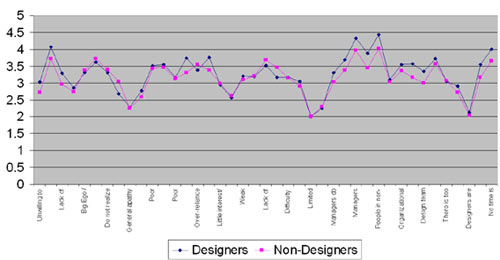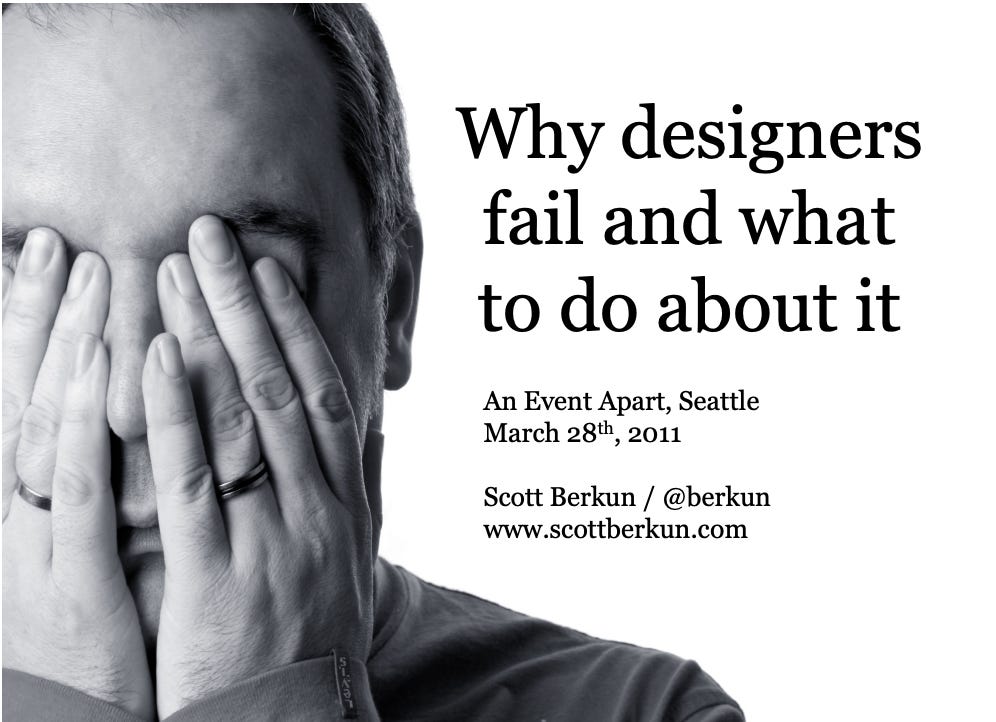Fail is a strong word. When I did this research years ago, I used that word to describe the results, rather than who was to blame for it. I hope it’s clear as you read this post that many people, not just designers, are responsible for the world as we know it.
For two years I lead the training for UX across Microsoft. This role required me to work daily with hundreds of designers, user researchers and UX managers on dozens of different projects. I learned where they were frustrated and why. I designed talks, workshops and events to help them be more effective.
When I left to become an author I wrote books on other subjects, including Making Things Happen, The Myths of Innovation and Confessions of a Public Speaker. But my love for design and trying to help designers remained. I knew the challenges of UX at Microsoft, but wanted to know: are these challenges universal? I followed this inquiry at many design conferences, which led to some of the research behind the perspective captured in Why Design Is Hard.
Data on why design is hard
In 2008 I looked for research about why designers struggle. I wanted comprehensive data on the psychological, skill and organizational challenges involved.
I found no shortage of opinions, including my own, but research was scarce. I decided to lead a research study and ask the community to help. I knew that publishing something, even if it’s flawed, is a magnet for people who know more to share related data you missed (so it’s a win either way).
The research
To prepare for a talk in 2008 (!) called Why Designers Fail, I did a survey of ~400 UX and tech professionals. The goal was to capture what makes design hard from the perspective of UX folks, but also their peers in other roles (since this is who we need to influence). Over 100 PMs, marketers and engineers participated.
I gave a talk summarizing the results several times, including MX ’08, An Event Apart Seattle ’08 and ’11. You can read the full resarch results here and the view the slides from the talk.
The top reasons designers fail in organizations
Here are the top reasons found from this research, (many of which are explored in Why Design Is Hard):
People in non-design roles making design decisions
Managers making design decisions w/o design training
Designers don’t seek enough data before designing
No time is provided for long term thinking
Designers not receptive to critical feedback
Lack of awareness of the business fundamentals
Only lip-service is paid to “User centered design”
Designer’s power diluted by too many cooks
Poor collaboration skills
Poor persuasion / idea pitching skills
Big Ego / Expects others to cater to their whims
Many of these reasons are far beyond an individual designer’s control, given the way most designers are trained. Which should not be a surprise.
Of particular interest was that managers, individuals, designers and non-designers all largely agreed about the reasons “designers fail”, as shown in this chart (full research results here). Even project managers and business leaders saw the challenges.
This data supports Why Design Is Hard
If you were nodding your head as you read the list above, the advice in Why Design Is Hard lines up with the way forward. It’s the only book I know of that takes these issues head on and provides good advice for the most frustrating situations.
From design talent is a distraction, to bad design makes money I’m convinced there is a new set of fundamentals every designer should learn early on in their career. Not because it’s necessarily fun to learn, but because it’s the truth. We need designers ready for the real world today, rather than wait for a world that is more design-friendly that will never come.
If you agree, I hope you’ll share this post and help spread word about this book. Our future as a profession depends on it, but I’m far from neutral for obvious reasons! So it’s up to you to decide what matters or not.
Is there more recent data you know of?
2008 is a long time ago. Have things changed much? I ask this as an honest question. I want a better designed world. That’s why I do this work. But making that happen is hard.
While I believe most of the challenges designers face today are similiar to what’s captured in this research (since they are about relationships, rather than tools or technologies), I’d love to see newer data confirming or challenging that assumption.
If you know of other similiar research, please leave a comment. I’d love to help support it. Thanks.






#1 and #2 are probably 80% of it. Humility I think has a big role for creative endeavors to generate value. Empathy is the other attribute and that might be correlated with humility to some extent.
As a testament to the fundamental quality and broad relevance of ideas in this book, Design Is Hard get's thumbs up from both me, residential interior designer, and my husband, a systems architect for manufacturing software. It's not just for UX and graphic designers!